AI applications have already taken hold across grocery retail, monitoring stock levels, boosting service and cutting shrinkage. Which tech is working best?
Jump to:

Smile. No, more. Smile harder. The corners of the mouth are not rising sufficiently. Now welcome a customer to store. A bit louder. A bit happier.”

So goes an interaction between new starters working for Japanese grocery chain Aeon and AI tool ‘Smile-kun’, which the retailer rolled out to “raise the standard of pleasant smiles and greetings” after it determined that “when interacting with customers, different people had different standards for smiling and speaking”.
Hence, since last summer, staff training at 240 Aeon stores face a tablet and deliver their welcome message and smile, while the software analyses and assesses their expression, volume, pronunciation, and tone in real time and feeds it back in the form of points and animated gold stars “in a fun, game-like way”.
It might sound like a plotline from Black Mirror, but it’s a real example of how AI is being adopted within grocery stores today. But which applications of AI in in-store environments are actually working, versus simply generating hype? Is it time to embrace AI or wait and see? How has the investment case changed as the technology advances? And what does the future hold?
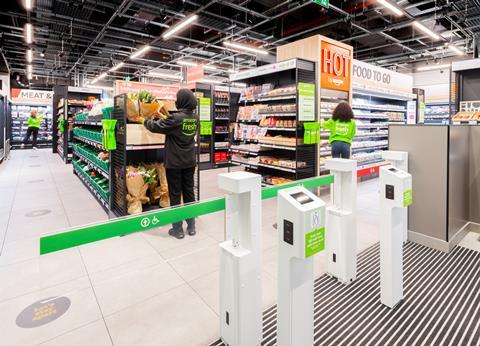
Admittedly, in most other cases, the implementation of AI is far less dystopian than Aeon’s, but there are robots, there are cameras, there are algorithmically blacklisted individuals – and there is the sense that once AI is truly out of the bag, things will never be the same again.
“Five years ago, this was mostly theory,” says Chris Camacho, CEO of marketing agency Cheil UK. “Today, it’s live in store. And we’re only scratching the surface.”
A supermarket running on AI is already far from science fiction. Amazon’s Just Walk Out technology, live in all its Amazon Fresh stores in the UK, uses a combination of computer vision, object recognition, advanced sensors, deep machine learning models, and generative AI to determine when a customer (or group of customers) has picked up a product, what they’ve picked up, and whether they’ve put it back again, so they can simply leave the store with the goods without stopping at a checkout.

“Without knowing the technology, it feels like magic,” says Gérard Medioni, VP and distinguished scientist at Amazon. “But creating that magic is harder than you think.”
Amazon claimed the technology would “redefine retail” when its first UK store launched in 2021. And many UK supermarkets didn’t want to be left behind. Tesco, Sainsbury’s, Aldi and others all ‘fast followed’ by launching frictionless, checkout-free stores using Just Walk Out or similar tech. They invested enormous resources, but it’s arguably turned out to be more of a misstep.
“The industry is experiencing a maturation phase, moving away from ‘AI for AI’s sake’”
“So far the concept hasn’t taken off,” says Jan Schneiderbanger, partner at LEK Consulting. “Most retailers who have tried it have either discontinued it or paused any further rollout.”
The number of Fresh stores in the UK has receded to 19, the initial lofty expansion plan having faltered. Tesco’s handful of GetGo stores now have a self-checkout option. Sainsbury’s in February stripped the tech from its sole SmartShop Pick & Go store, while Aldi is struggling to make its only Shop & Go format store work.
This “roll back”, as Schneiderbanger puts it, is typical of many in-store AI initiatives. “Many use cases are also still relatively new and unproven, and there’s a reluctance to invest heavily before there’s greater certainty,” he says.
But AI is also being put to use to solve well-understood issues within stores, not just enable a theoretical future of grocery shopping.
“The industry is experiencing a maturation phase, moving away from ‘AI for AI’s sake’, as retailers shift from multiple experimental investments to concentrating on larger-scale transformative technologies that deliver tangible results and impact the bottom line,” explains Henry Ayres, head of engineering practice at Daemon, a digital transformation consultancy that works with Sainsbury’s.
“Vital to this is separating the ‘substance’ from the ‘noise’ and only adopting technologies that will enhance operations in the long term,” Ayres adds.
Take availability. In April last year, Morrisons began deploying AI-powered cameras from Seattle-based AI company Focal Systems in its stores that can detect in-stocks, out-of-stocks, lows, planogram non-compliance and spoiled produce. The system scans shelves every hour, alerting staff to priority actions accordingly.
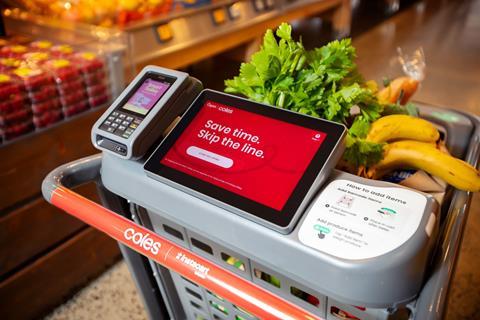
It’s all possible, says Focal Systems CEO Kevin Johnson, due to “a convergence of several major advances in AI and supporting technologies over the past few years”.

“Most notably, deep learning breakthroughs in computer vision have enabled the precise identification of products, shelf conditions, and anomalies in highly complex and dynamic retail environments,” Johnson says. Further, advancements in edge computing bring computational resources closer to the cameras so they can process data locally without having to send it to a faraway server, saving time and cost.
“At the same time, improved cloud infrastructure supports seamless integration with retailer systems, enabling AI-driven decisions to directly power replenishment, workforce management, and analytics,” Johnson adds.
The hardware – in this case, small cameras fitted to shelf edges and on poles to provide a view of around eight feet of shelf space opposite – is now cheaper, more efficient and able to capture higher resolution imagery.
“Combined, these innovations have transformed what was once a manual, time-consuming process into a fully automated, intelligent retail operating system – making real-time shelf visibility not just possible, but powerful,” Johnson says.
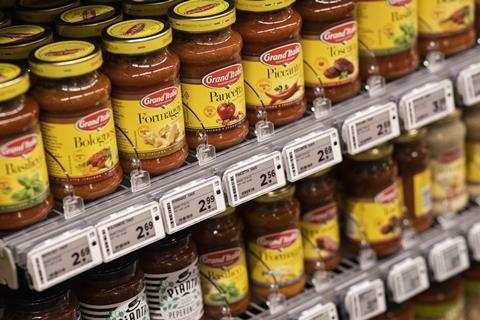
Late last year, Morrisons completed a rollout of the cameras across its entire estate, having been trialling the tech only months earlier.
AI is also taking on shrinkage. According to the BRC’s 2024 Crime Survey, losses from customer theft now cost retailers £1.8bn per year. On the one hand, technology has enabled much of the crime supermarkets face. Some 37% of UK shoppers have failed to scan at least one item when using self-checkouts, according to exclusive research for The Grocer by Toluna Harris Interactive. On the other, it’s hoped that technology can help too.

Tesco’s Just Walk Out tech partner Trigo – in which Tesco announced an equity investment in 2019 – is adapting its technology to identify what items a shopper picks up and compares it against what they scan at a self-checkout.
“Shrinkage is one of the most pressing challenges facing retailers today, and we’re already seeing the consequences with more items being locked away – ultimately harming the shopping experience for honest shoppers,” says Daniel Gabay, co-founder and CEO of Trigo. “Computer vision AI offers a smarter alternative. If an item is taken but not scanned, an alert is triggered across all checkout methods. This catches both accidental and deliberate theft – all while maintaining customer privacy and a frictionless shopping experience.”
Crucially for grocers considering shelling out against shrinkage, because the system works via existing CCTV cameras it requires “no additional infrastructure” and can roll out into a store within two months with “minimum disruption to operations”.
AI is also being employed as an agent for store staff to interrogate on stock availability, store wayfinding and even what task to carry out next. It’s being connected to electronic shelf labels to manage inventory and pricing, used to optimise store layouts and staff rotas, and to generate unique experiences for customers.
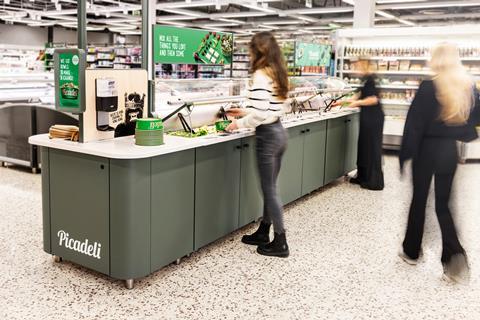
Five AI innovations being trialled

Picadeli:
Found in more than 2,200 stores across Europe and the US, Swedish firm Picadeli’s AI-powered salad bar automatically keeps track of inventory and uses AI to suggest what and how much to order.
The company’s algorithms also factor in weather and public holidays to help ensure availability and minimal waste. Traditional salad bars often require 50 to 60 hours of labour per week, Picadeli claims – its digital processes and automated ordering systems reduce this to around 15 hours.
M&S AI Wine Finder:
In response to “a few quick questions about personal preferences”, shoppers at 20 M&S food halls are served tailored recommendations of wines ranged in that store, with the retailer’s ‘AI Wine Finder’.
Developed with AI tech company Preferabli, M&S began trialling the tool in February “to help customers shop a category that can be confusing”, it said. It taps “the largest group of Masters of Wine and Master Sommeliers in the world”, and Preferabli’s proprietary database, to suggest the best drop.
Caper Cart:
In February, Australia’s Coles supermarket introduced AI-powered trolleys – or ‘Caper Carts’ – made by US delivery giant Instacart. Caper Carts are equipped with AI, cameras, and a built-in scale, which work together to recognise items as they are added to the trolley. The trolleys can be synced to a shopper’s rewards programme account, and can spin a digital wheel for the chance to win discounts on the trolley’s screen at checkout.
Too Good to Go AI:
Surplus food marketplace app Too Good To Go last year launched an AI-powered platform aimed at retailers seeking to draw more margin from near-expired food and reduce food waste.
The platform’s algorithms can generate and display a near-expiry product shortlist on store staff’s handheld devices, as well as recommend “exactly what to do with each near-expired product”, based on pre-set, customisable rules and preferences. It might suggest a discount sticker at an optimised rate be printed to sell the product, or for it to be added to a Surprise Bag to sell on Too Good To Go, or for it to be donated.
It’s being rolled out by Spar International across its 14 markets.
AI self-scan spy:
Since April, variety discounter Home Bargains has been working with UK loss-prevention tech firm SAI in the deployment of AI-enabled cameras that can detect items that have passed a checkout without being scanned.
It analyses hand movements in real time, detecting whether an item is correctly scanned or deliberately bypassed. The technique can also spot if a barcode has been obscured or a fraudulent barcode used.
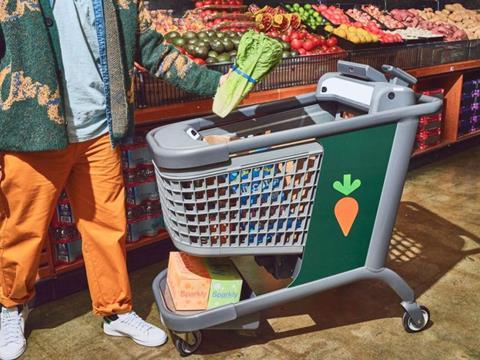
Barriers to adoption
Such examples, says Camacho, prompt the question: “So, why is this not everywhere?”
“Capital investment remains a major barrier,” he says. “Retrofitting legacy stores with the infrastructure to support AI is expensive and complex. There’s also fatigue around unproven tech and pilots that fail to scale. Retailers now want impact, not just innovation.”

“The hardware and software needed for these technologies involve considerable upfront investment and ongoing maintenance,” adds Catherine Strowger, head of retail at Capgemini Invent.
But – at least in the case of shelf camera technology – while “capex is often cited as a barrier, it’s not the primary reason many grocers hesitate to roll out”, says Focal Systems’ Johnson.
“The bigger challenges are competing priorities, risk aversion, and a tendency to stick with the status quo,” he says. “In many cases, the mindset is: ‘It’s always worked this way—why change?’ Even with compelling return on investment, real-time visibility, and labour-saving benefits, shifting away from long-standing processes requires a willingness to rethink operations and embrace new ways of working.”
“Retrofitting stores with the infrastructure to support AI is expensive and complex”
Besides, the financial pain of a major AI implementation is diminishing. “A big part of what’s made this possible is cheaper, more accessible compute power and better edge devices,” says Vineta Bajaj, former Ocado Group CFO, now CFO for pan-European online grocer Rohlik Group.
“You don’t need a full data centre to run these models any more – some can now operate in-store with minimal latency, making real-time responses viable. That’s what’s unlocked a lot of this progress. Pair that with increasingly accurate computer vision models and you’ve got solutions that are finally good enough to deploy at scale,” she adds.
Taking generative AI as an example, the cost of querying an AI model like ChatGPT or Meta’s Llama fell from $20 per million tokens in November 2022 to just $0.07 per million tokens by October 2024, according to analysis by Stanford University.
While “the headwinds are practical – cost, complexity and change management”, increasingly “the tailwinds are just as strong – staff pressures, customer expectations and the sheer need to do more with less”, according to Bajaj. “AI offers answers to all of those, so the momentum is only going one way.”
The government’s AI action plan

The UK “risks falling behind” advances in AI made in the US and China, secretary of state for science, innovation and technology Peter Kyle warned this year, as the government published its AI Opportunities Action Plan.
As Kyle put it: “We want Britain to step up – to shape the AI revolution rather than wait to see how it shapes us.” The plan will ensure the UK is an “AI maker, not an AI taker”.
The plan includes: a 10-year investment commitment to the infrastructure AI relies upon; the building of ‘AI Growth Zones’; the training of tens of thousands of additional AI professionals; and the removal of “private sector user adoption barriers”.
The government will also “actively incentivise and reward” the private sector to unlock their datasets for use by researchers.
This month sees the introduction of increases to the national living wage and national minimum wage, ramping up labour costs and forcing retailers to review their pay structures. And in October, the threshold at which companies pay National Insurance on employees’ wages will lower, while the rate will rise from 13.8% to 15%.
With those changes, the case for AI solutions that make workers more efficient, or handle their tasks for them, gets boosted. Especially when costs elsewhere in the business are rising too.
Now, then, is not the time for skunkwork, moon-shot type innovation, but tried and tested solutions that clearly pay off.
“With retailers feeling the knock-on effects of global economic pressures, adoption will be driven by de-risked ROI,” says Daemon’s Ayres. “Scalable AI and data-led solutions that demonstrate clear returns, demonstrably optimising store operations and directly boosting sales will be the easiest to justify implementing.”
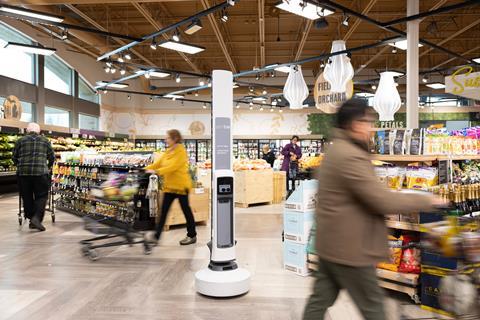
While there are some grocers that “remain sceptical and want more real-world proof points before scaling the technology”, Johnson says, many more are recognising the advantages and ROI of AI.

However, “many grocers are held back by legacy IT systems, which are often fragmented or outdated, making integration with new digital platforms difficult and costly”, according to Strowger.
After all, AI solutions don’t work in isolation. Connecting them up with existing – often far older – systems can prove troublesome.
“Many of the more advanced use cases require integration with existing systems and high-quality unified data, which is challenging for many grocers that are still using legacy systems and still working through data integration challenges as part of their business-as-usual operation,” Schneiderbanger adds.
As Bajaj puts it: “Many legacy systems don’t play nicely with AI tools, and rolling out new tech at scale without disrupting day-to-day operations is a huge undertaking.”
Case study: Morrisons’ fast and furious Focal Systems roll out
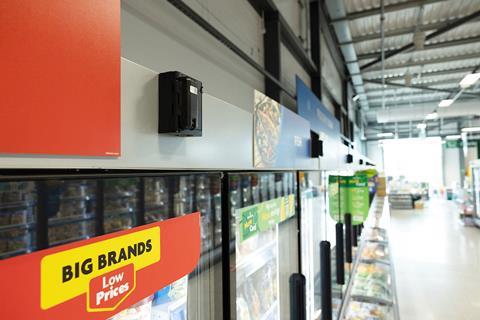
“The speed of our rollout often surprises people,” says Focal Systems CEO Kevin Johnson.
While several supermarkets are trialling shelf-edge cameras to monitor stock, Morrisons’ adoption and rollout across its estate has been swift. It had trialled other providers “but never felt confident to extend the trials”, says Jess Dobson, who led the project as head of productivity, now property director.
But “we could clearly see how this and the supporting task management system was reducing wasted effort for our colleagues”, she adds. So why wait?
The time and resource requirement of AI rollouts is an important consideration. Especially as it’s often only at scale such solutions prove their value.
“A full installation in a large-format supermarket can be completed in just one evening,” Johnson says. “This speed and ease of deployment – combined with our experienced installation teams and streamlined onboarding process – is how we’ve been able to scale so quickly,” he adds.
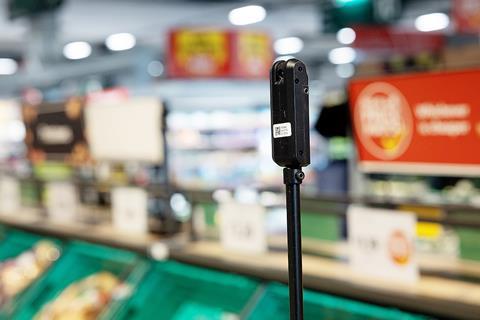
Human fears
There is also change management to consider. AI rollouts are typically big in scale and can heavily impact ingrained ways of working, meaning staff must be brought on the journey – concerns that AI will replace them are real.
“There’s a reasonably common fear among colleagues that these initiatives are there to automate them out of a job, leading to resistance and a requirement to manage adoption and literacy in the subject,” says Jeff Watkins, chief technology officer at CreateFuture, a digital transformation company that has worked with Tesco Bank and Heineken. “However, the world of grocery is constantly changing, and the intense competitive pressure should shock laggards into action.”

AI is also data-hungry, particularly for customer data, giving rise to privacy concerns and regulations to navigate.
“Solutions like computer vision or tracking customer movement bump up hard against privacy laws,” explains Tom Purton, head of the commercial, technology & outsourcing team at law firm RPC. “Until regulators like the Information Commissioner’s Office provide clearer guidance, such as its proposed AI Code of Practice, many retailers will be wary of pushing into higher-risk areas like biometrics or facial recognition.”
Add facial recognition to the mix and the risks rise further. Plus, public perception of AI isn’t exactly positive.
“Thanks to a mixed bag of PR around AI, there’s also a heady mixture of GDPR, customer acceptance and trust issues that needs to be navigated, with supermarkets unlikely to welcome backlash from a mishandled implementation,” Watkins adds.
“There is confidence AI can deliver both operational and customer value”
But the challenges are worth overcoming. Especially with many arguing that the tailwinds are beginning to blow stronger than any headwinds.
“As early adopters demonstrate real operational gains and improved margins, we’re seeing momentum build. The question is shifting from ‘should we?’ to ‘where do we start?’ and ‘how fast can we get there?’” says Julian Skelly, retail lead, EMEA & APAC, Publicis Sapient.
“We’ve reached a tipping point where the technology is proven, infrastructure is more accessible, and the business case is clearer – especially in areas like shrink reduction, product availability, and colleague productivity,” Skelly adds.
“There is also growing confidence among boards and leadership teams that AI can deliver both operational and customer value when deployed responsibly.”
It does indeed seem that change is coming. A survey of the UK’s top 100 retailers by TLT found 80% in the grocery sector were positive about the transformative impact of AI on their businesses.
“For grocers with a clear vision and the right partners, these technologies are no longer experimental,” Skelly adds. “They’re becoming essential.”




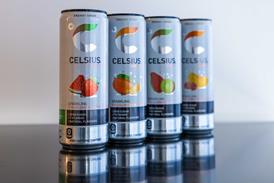


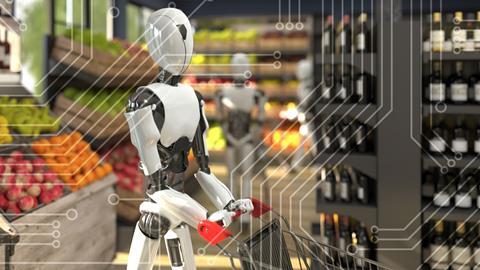
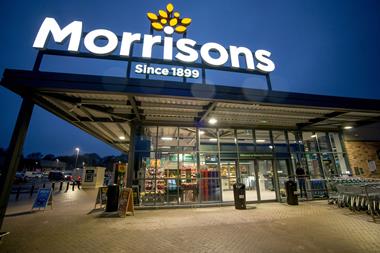


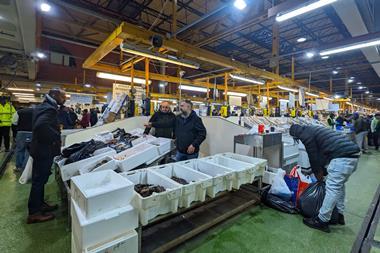


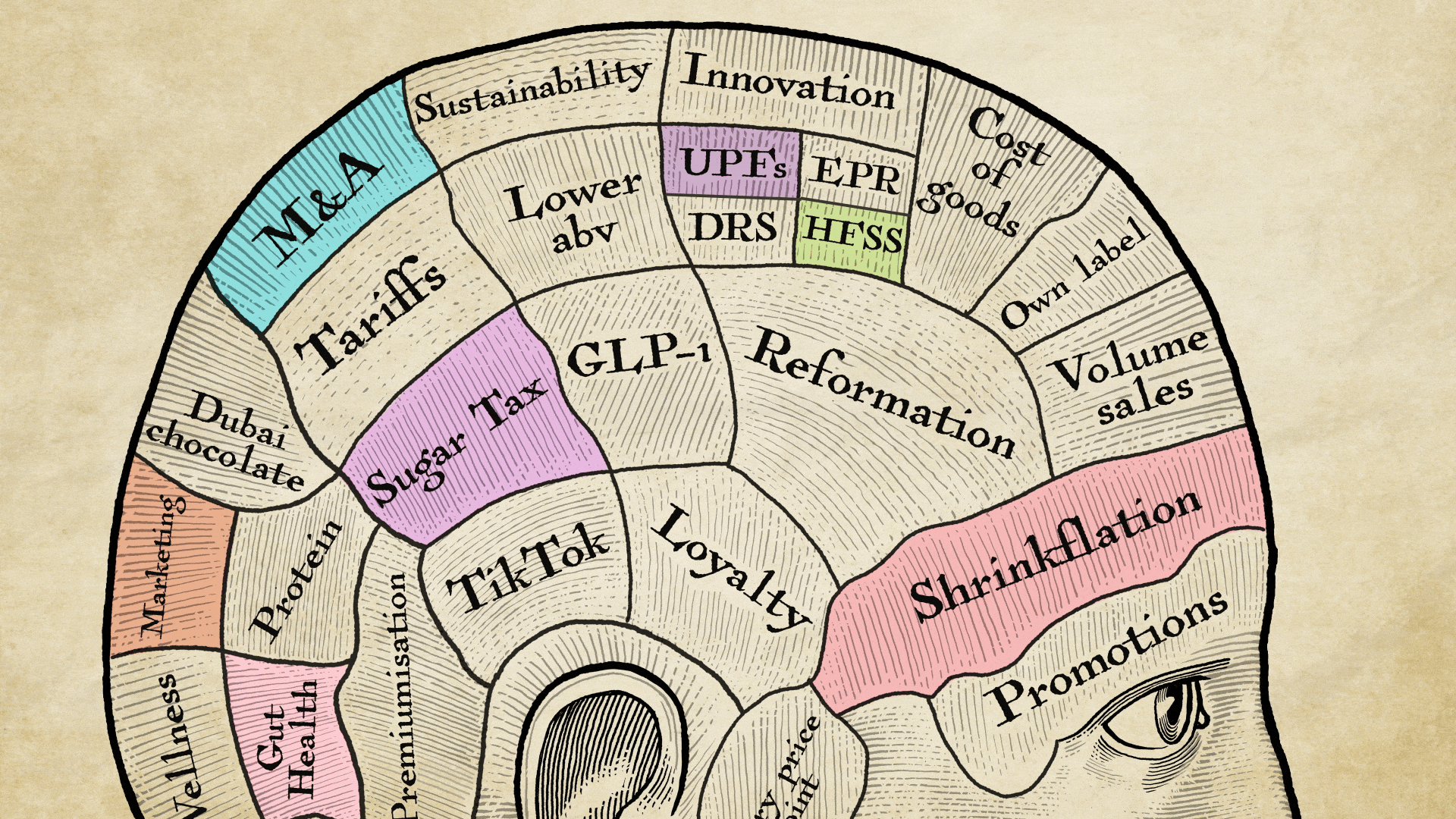
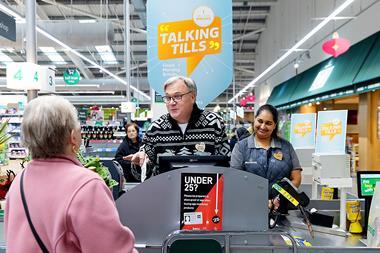




No comments yet